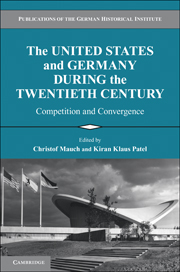Book contents
- Frontmatter
- Contents
- Contributors
- Acknowledgments
- 1 Modernities: Competition versus Convergence
- 2 Empires: Might and Myopia
- 3 Religion: Belief and Power
- 4 Law: Constitutionalism and Culture
- 5 Welfare: Entitlement and Exclusion
- 6 Immigration: Myth versus Struggles
- 7 Masses: Mobilization versus Manipulation
- 8 Market: Consumption and Commerce
- 9 Authority: Schools and Military
- 10 Gender: Equality and Differences
- 11 Environment: Conservation versus Exploitation
- 12 Film and Television
- 13 Education: Universities and Research
- 14 Media: Government versus Market
- Index
3 - Religion: Belief and Power
Published online by Cambridge University Press: 12 October 2018
- Frontmatter
- Contents
- Contributors
- Acknowledgments
- 1 Modernities: Competition versus Convergence
- 2 Empires: Might and Myopia
- 3 Religion: Belief and Power
- 4 Law: Constitutionalism and Culture
- 5 Welfare: Entitlement and Exclusion
- 6 Immigration: Myth versus Struggles
- 7 Masses: Mobilization versus Manipulation
- 8 Market: Consumption and Commerce
- 9 Authority: Schools and Military
- 10 Gender: Equality and Differences
- 11 Environment: Conservation versus Exploitation
- 12 Film and Television
- 13 Education: Universities and Research
- 14 Media: Government versus Market
- Index
Summary
For quite some time, the modern era has been viewed as a period in which faith, religion, and the church have been in decline.Movements such as industrialization and urbanization and the rise of science and technology were considered to be much more characteristic of this era. The “demystification of the world” that accompanied these movements seemed to rupture irrevocably the fragile unity of the religious and social spheres of life. Our modern, increasingly more mobile society – oriented toward market forces, performance, and competition – has established new ways of life. Religion, so it seemed, was a dinosaur headed toward extinction.
The German past and present seem to confirm this prognosis. One-third of the German population is now without any religious affiliation. In the eastern states, (the former GDR), this category covers nearly three-quarters of the population. Although more than 80 percent of those living in the GDR still belonged to a church (primarily Protestant) in 1950, this figure had slipped to only 24 percent by 1989, and there is nothing to suggest now that this trend will reverse itself. Despite the fact that the churches and clergy played a crucial role in the peaceful revolution of 1989, churches in eastern Germany remain empty today, and the secular coming-of-age celebration initiated during GDR times is still more popular than the Christian confirmation ceremony. In the “old” states in western Germany, especially in the large cities, the importance of the church is also waning. The number of weddings and baptisms performed in western Germany has been in steady decline since the 1960s, and even among those who balk at leaving the church, only a minority (16 percent of all Catholics and 4.6 percent of all Protestants) still regularly attend Sunday services. In 2002, only 7 percent of Catholics under thirty years old declared themselves to be close to the church. Even in questions of personal morality, only a small minority of Germans recognize their churches as a source of social authority. Religiously affiliated schools in Germany are also a marginal phenomenon; they enroll scarcely more than 4 percent of all pupils.
In the United States, we encounter a very different situation. A rich and diverse religious culture continues to exist. A large number of Americans consider faith in God to be an indispensable prerequisite for a modern, well-functioning community.
- Type
- Chapter
- Information
- The United States and Germany during the Twentieth Centurycompetition and convergence, pp. 32 - 51Publisher: Cambridge University PressPrint publication year: 2010

